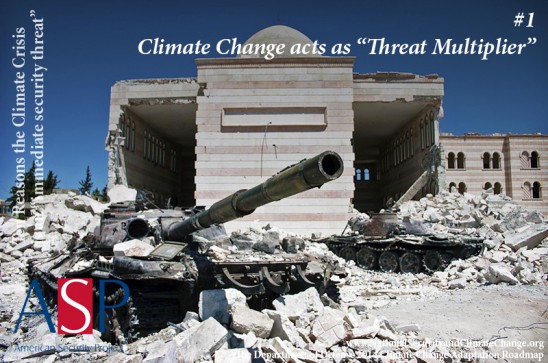
The DHS Response to Climate Change
On July 8th, the Subcommittee on Oversight and Management Efficiency of the House Committee on Homeland Security held a hearing about the Department of Homeland Security’s response to the growing threat of climate change. Subcommittee Chairman Scott Perry (R-PA) called the hearing to examine DHS’s “misplaced focus” on climate change, and asked questions of two panels of witnesses.
As ASP has written, “it is entirely appropriate for DHS to prepare for the impacts of climate change.” Indeed, each of the four witnesses testifying before the subcommittee stressed the importance of considering climate change as a “threat multiplier,” which exacerbates preexisting instability by decreasing access to food and water resources, driving migration, increasing the frequency and intensity of extreme weather events, and changing disease environments.
The first panel of witnesses was comprised of DHS Acting Assistant Secretary for Strategy, Planning, Analysis, and Risk Thomas Smith; Federal Emergency Management Agency Deputy Associate Administrator Roy Wright; and DHS Deputy Assistant Secretary for Infrastructure Protection Robert Kolasky. They each faced questions regarding the varying priority DHS assigned to investigations into risk posed by climate change and the threat of violent terrorism. The witnesses responded by explaining that many threats to national security are interrelated, and that it would not be possible to completely separate the influence of climate change from other risks. When pressed, Smith described climate change as a threat multiplier rather than a direct threat, which accounts for the wide impact climate change has on environmental conditions that underlie extremism, migration, and other factors challenging national security.
Many questions to the first panel of witnesses centered on whether analysis of climate change threats distracted the department from other challenges, ranging from terrorist groups like ISIS and Boko Haram to nation-states such as Iran and China. Smith responded by noting that more traditional threats fell under DHS’s core missions of preventing terrorism, securing borders, enforcing immigration laws, safeguarding cyberspace, and ensuring disaster resilience, and so would not be represented in additional appropriations requests or organizational charts. Climate change risk assessment, as a less obvious fit, therefore had money explicitly assigned. To answer specific concerns about FEMA’s role in assessing climate risk, Wright reassured the subcommittee that FEMA’s primary objective remained organizing responses to extreme weather events.
When asked why DHS analyzed the threat of climate change, in a seeming duplication of other agencies’ climate research, Kolasky and Wright in particular stressed that different agencies have different areas of expertise. NASA, NOAA, and the US Geological Survey may be particularly skilled in collecting climate data, but the scientific agencies do not perform the same kind of risk assessment that DHS includes in its reports, most importantly the Quadrennial Homeland Security Review. DHS places special emphasis on the threat posed to US infrastructure by climate change, with Kolasky highlighting energy, transportation, water, and communications infrastructure systems as specific systems vulnerable to climate change-related risk.
Marc Levy, Deputy Director of the Center for International Earth Science Information Network at Columbia University was the final witness. The prepared version of his opening remarks cited ASP’s “Global Security Defense Index on Climate Change,” which is a collection of world governments’ considerations of climate change as an issue of national security. In his opening statement, Levy described the world as a more dangerous place thanks to the threat of climate change, and said that the US government should do more and not less to understand and respond to the risk. Several specific instances show that we are losing rather than gaining ground, he said, particularly the closing of the CIA Center for Climate Change and other programs that fostered cooperation between the scientific and national security communities.
Levy added his voice to those of the previous witnesses when describing climate change as a threat multiplier, and stated that climate change has already contributed to instability in strategically important areas. He also agreed with the earlier witnesses that threats to national security are interconnected, and that climate change’s impact cannot be ruled out as a contributing factor to terrorist activity.
As Levy concluded, DHS and other government agencies should increase their efforts to study and understand climate change as a threat to national security.






